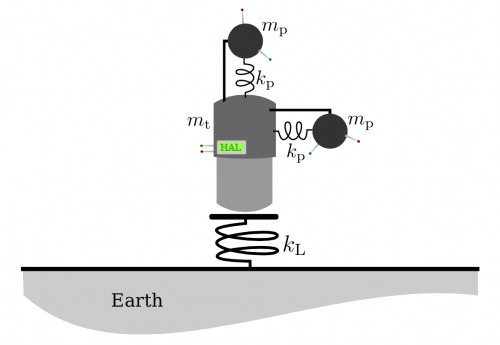Project 9: Learning goals
- For multi-particle systems where little or no heat is exchanged with the surroundings, use conservation of energy (ΔEsys=Wext) to explain and/or predict the final state of the system (this includes accounting for the potential energy of each pair of interacting particles; spring potential energy).
- For a system that can be modeled as two-point particles, use conservation of energy and linear momentum to explain and/or predict the final state of the system after a one-dimensional collision has occurred.
- Use the center of mass system to explain the motion before, during, and after the collision of two objects that can be modeled as point particles.
- Determine the net force acting on a single-particle system using a diagrammatic representation (free-body diagram) and by performing any necessary calculations.
- Generate free body diagrams for single-particle systems where the momentum is changing (direction and/or magnitude) to explain the motion of the system and/or to predict various physical quantities associated with the system.
- Decompose the net force vector parallel and perpendicular to the direction of motion to explain how the momentum of a single-particle system changes magnitude and direction and apply this decomposition to explain/predict phenomenon such as decreased/increased apparent weight, the motion of gravitationally interacting bodies, and wires snapped during motion.
Project 9: Learning Concepts
- Gravitational potential energy
- Spring potential energy
- Energy conservation
- Momentum conservation
Project 9: Part A: Launching a communications probe
You and your team are engineers that have been contracted by Elliot Carver of the Carver Media Group Network (CMGN) to plan the launch of their new “communications” satellite. The satellite is meant to perform a geosynchronous pole-to-pole orbit.
The satellite consists of a transmitter of mass ($m_t$ = 4500kg) connected to two perpendicularly directed ejectable spring-loaded probes (each having mass $m_p$ = 400kg). Each probe is connected to a single, very stiff spring ($k_p$ = $5.3\times10^9$ N/m). The probes can be ejected by remote control from the CMGN headquarters in Freer, Texas; springs can be compressed as needed. A mockup from CMGN's lead designer, Wai Lin, appears below.
CMGN is going green with their satellite launches. Their new design uses no fossil fuels. The satellite itself is launched from CMGN's launch facility in the South Pole with yet another spring system, oriented vertically with respect to the flat launching platform. This very stiff spring ($k_L$ = $8.3\times10^8$ N/m) can be compressed as needed.
The satellite contains a gyroscope that self-orients the satellite with respect to the gravitational force due to the Earth, such that the satellite remains in its original orientation throughout the entirety of its trip.
Carver needs you to plan the launch and any subsequent course corrections needed to get the satellite into a geosynchronous pole-to-pole orbit.
Conceptual questions:
- What was your system? What was/wasn't included and why?
- Instead of compressing the spring the correct amount, you over-compress it. What impact will this have on your solution and would there be anything you could do to correct this error after launch, if so what?
- As it turns out, launching from the South Pole is very expensive. The launch site has been moved to Nanyuki, Kenya on the equator. How does this impact your solution?
- Where would friction play the biggest role? How would this change the launching stretch?
- Why is the Newtonian gravitational potential energy negative here? Why isn't the spring potential energy negative? Why isn't local gravitational potential energy negative?
Project 9: Part B: Launching a Communications Probe - Computation
Carver has a lot of money wrapped up in this satellite, so he wants your team to simulate the orbit of the satellite. His lead computer scientist, Henry Gupta, has gone missing but left a piece of code that demonstrates the orbit of the satellite (or so he claims, Carver isn't really much of a scientist).
He wants you to make sure that Gupta's simulation does accurately represent the motion of the system. Using graphs of the movement of energy in the system and adding an arrow that represents the net force vector would convince him. To really impress Carver, you should add additional arrows representing the parallel and perpendicular components of the net force.
https://www.glowscript.org/#/user/pcubed/folder/incompleteprograms/program/LaunchingSattelite
